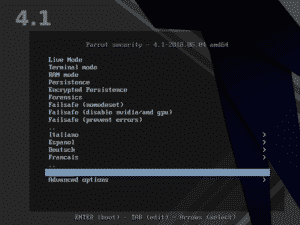
$> usermod -l new_name -d /home/new_name -m user Optional: Tools, Setup and Customizationīelow are the basic tools and configurations that make it all more usable, efficient and visually pleasing.įirst, you might want to change the default user from ‘user’ to your own username represented by ‘new_name’ below. Boot from the USB and this time from Parrot’s main menu select ‘Advanced’ and then ‘Persistence’.Īfter that Parrot is ready to use and any changes will persist between reboots.
PARROT OS FILE PERMISSION PC
Make sure to hold down the ‘option’ key on the Mac or F12 on PC to get to the boot menu. $> echo "/ union" > /mnt/usb/nfĬlose the terminal and reboot.

In the main menu click ‘Edit and apply’ and then close gparted.īack in the terminal $> mkdir -p /mnt/usb Leave all the options as their defaults but change the ‘label’ input to ‘persistence’ and click ‘Add’. In the gparted gui, select the usb drive, right click on ‘Unallocated Space’ and click ‘New’. Type the following commands $> wipefs /dev/sdb In the examples below my drive was at /dev/sdb. Creating the persistence partition will require you to be the root user so elevate to that user with ‘sudo su’.Īt this point, again, identify the usb stick with ‘fdisk -l’.

Select the USB as the boot drive.įrom Parrot’s boot menu select ‘Try/Install’ and wait for Parrot to boot up Creating PersistenceĪfter the boot process is complete open the terminal. Typically the brand name will be displayed by balenaEtcher but make sure that is the only drive you have selected so as not to unintentionally wipe any other drives.Īfter that’s done insert the USB and reboot your computer holding down the ‘option’ key on the Mac, and on most PCs the F12 key.
PARROT OS FILE PERMISSION INSTALL
Download links are available on their site but if you’re on a mac and use Homebrew you can: $> brew install balenaetcherīefore flashing the USB make sure the correct drive is selected.
PARROT OS FILE PERMISSION ISO
Next step is to download the latest Parrot ISO image and do a bit by bit copy of that ISO to your usb with balenaEtcher. _filename="/mnt/backup/dotfiles_$_"įind ~ -maxdepth 1 -type f -iname ".*" -exec tar cvf $_filename +

# plugin an external drive and then `sudo fdisk -l` to get its number to use in the script, in the example below mine was /dev/sdd2 That would include the applications I’ve installed in my /opt folder, and then my data and other files in a directory named Dev in my home directory. The first thing I do is backup my applications and files from the usb I’m about to decommission. Samsung 128gb 400mbs flash drives have worked well for me over the past few years. If you paid around $10 then your drive will probably be too slow to be usable. You will need a somewhat fast flash drive.


 0 kommentar(er)
0 kommentar(er)
